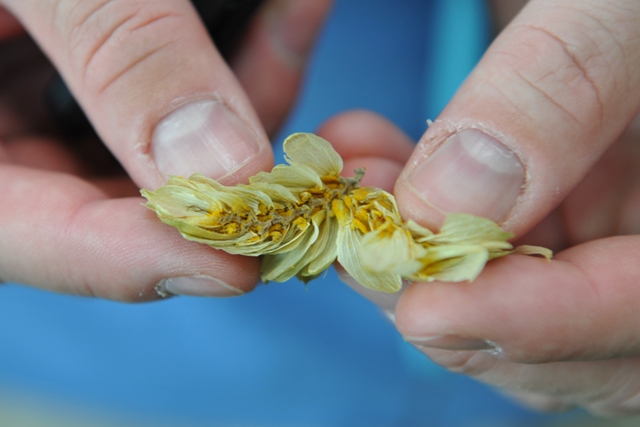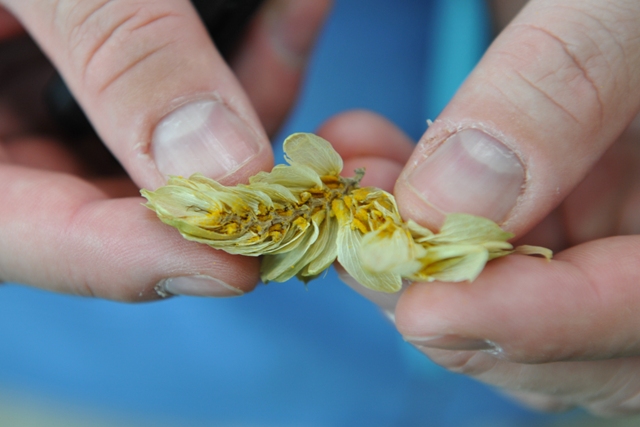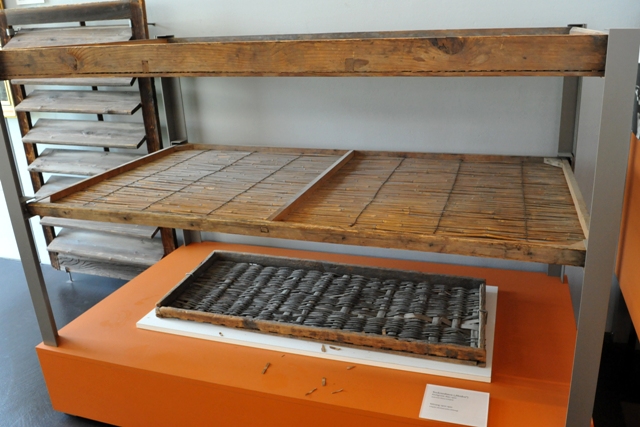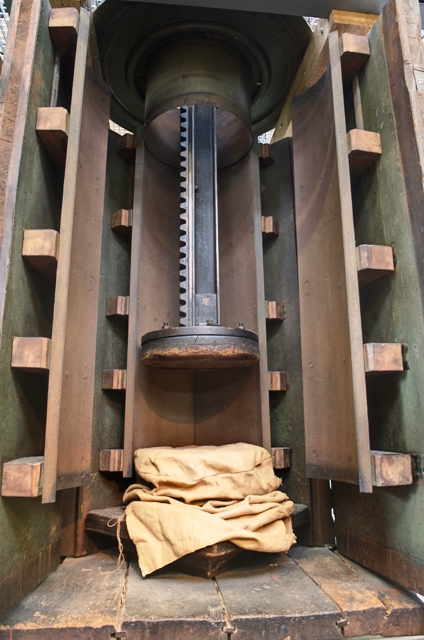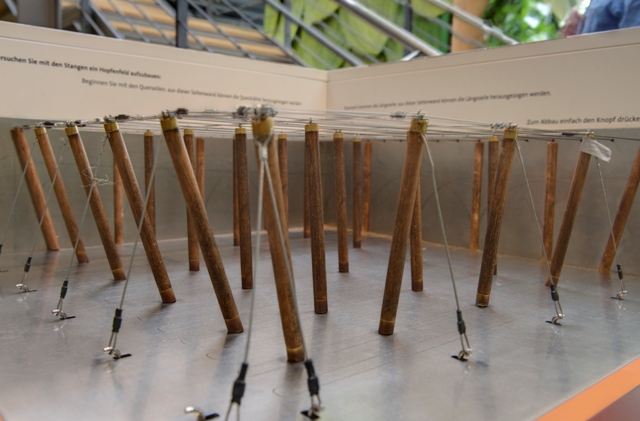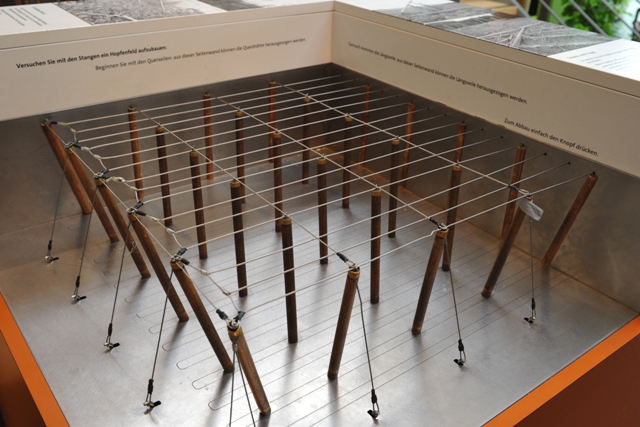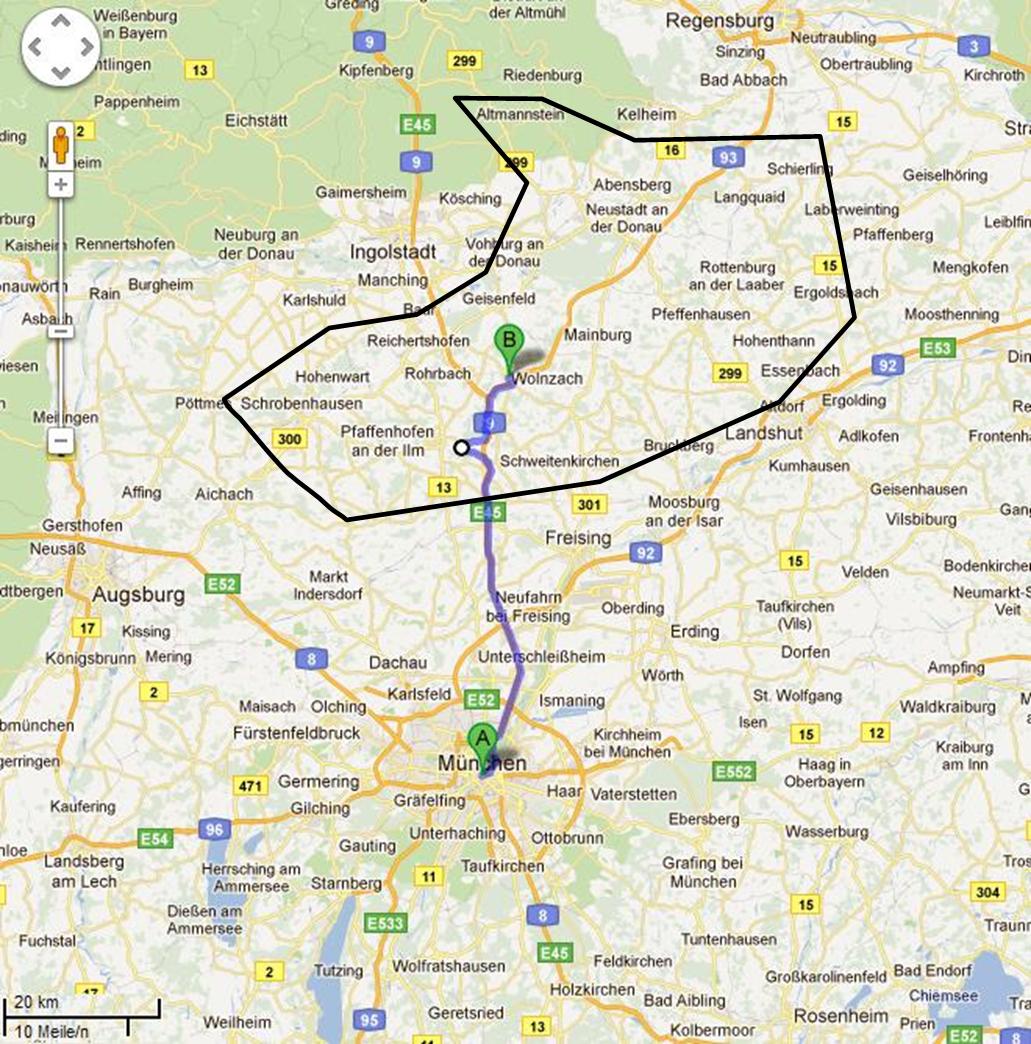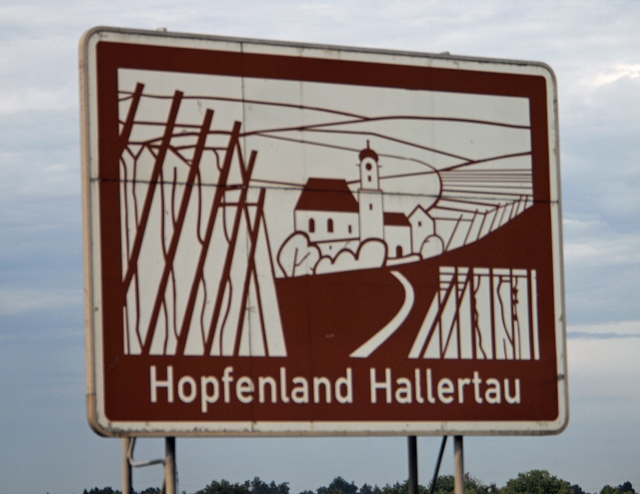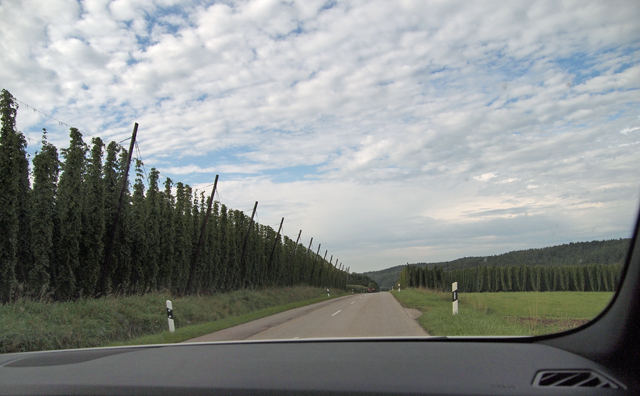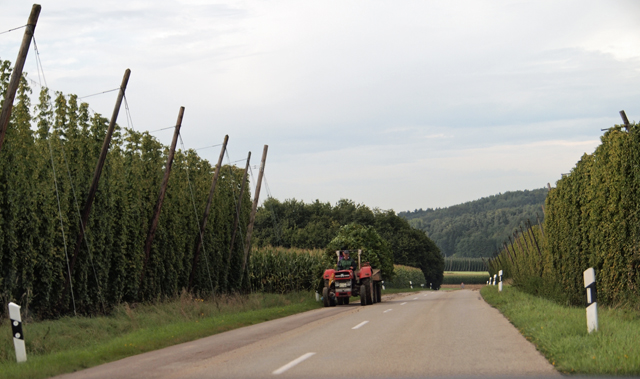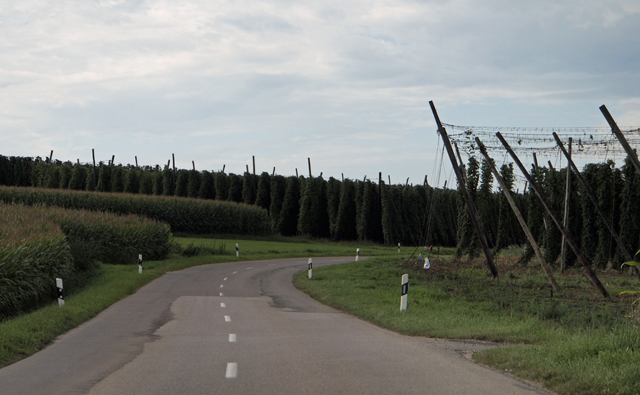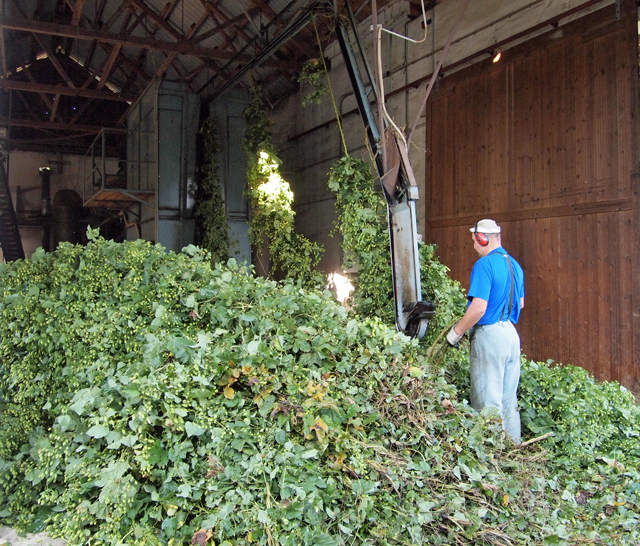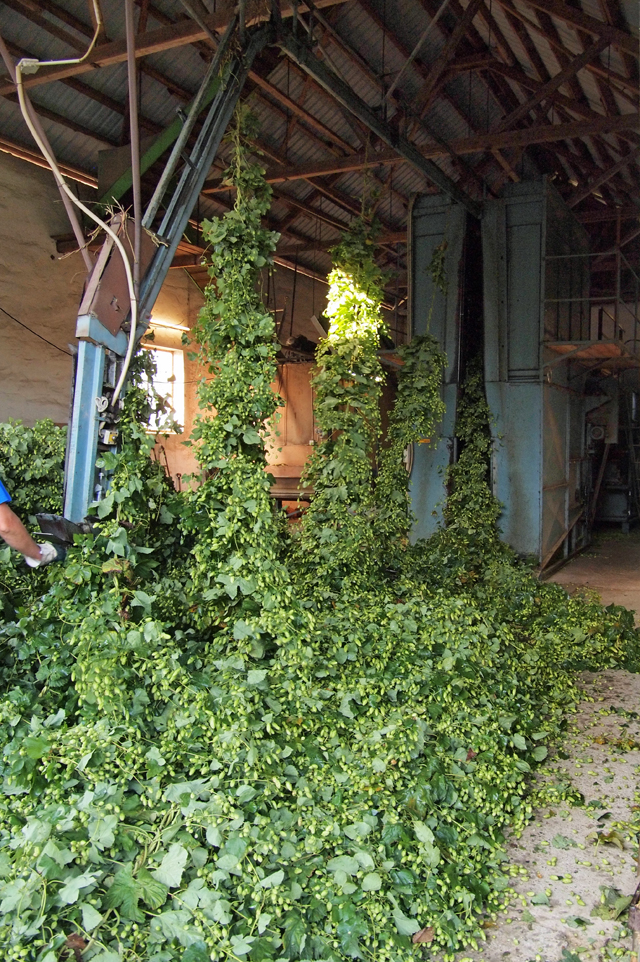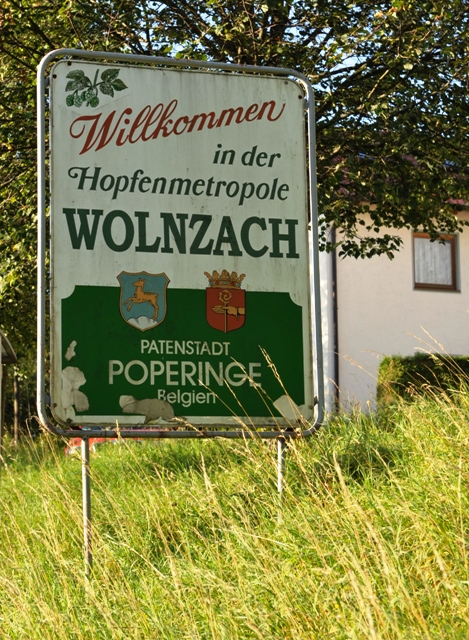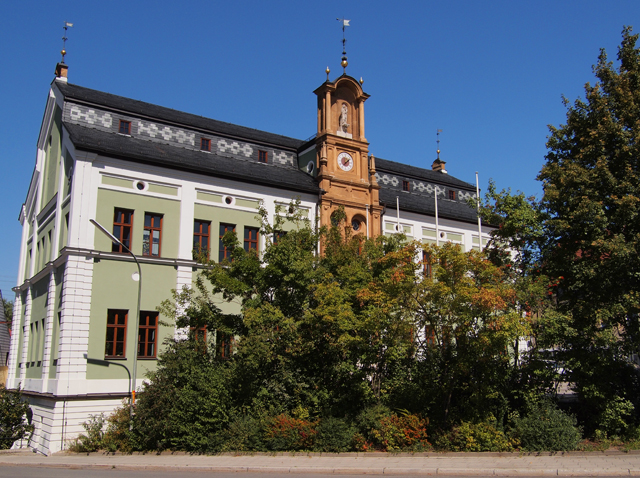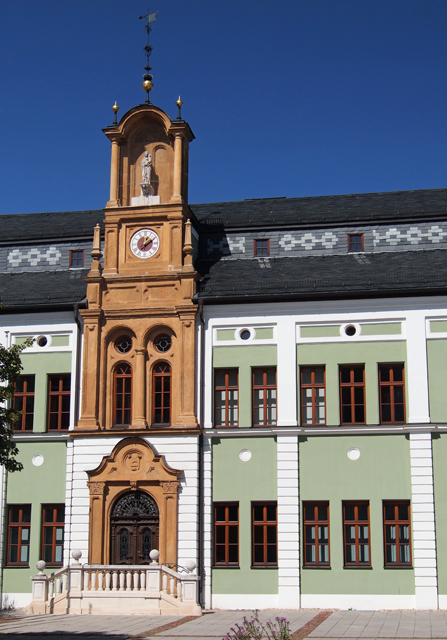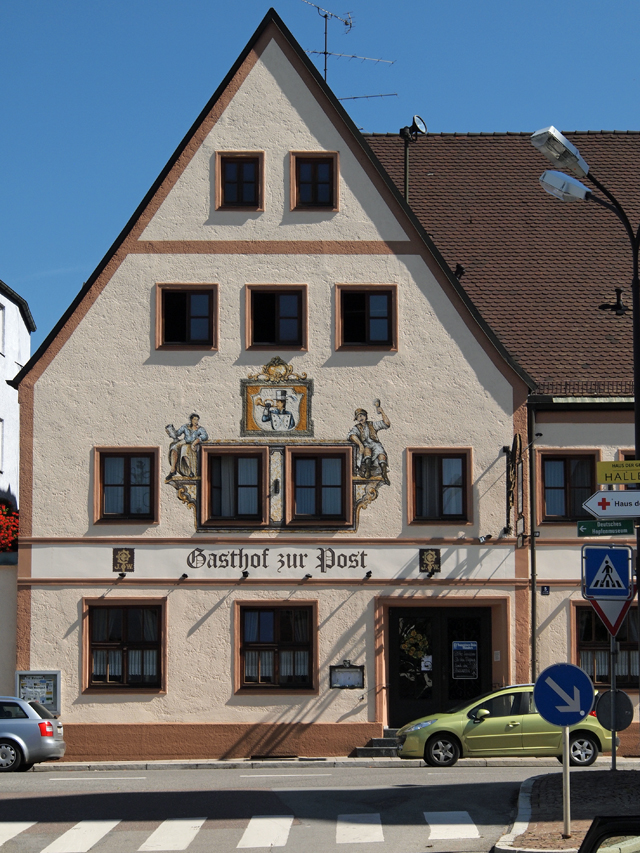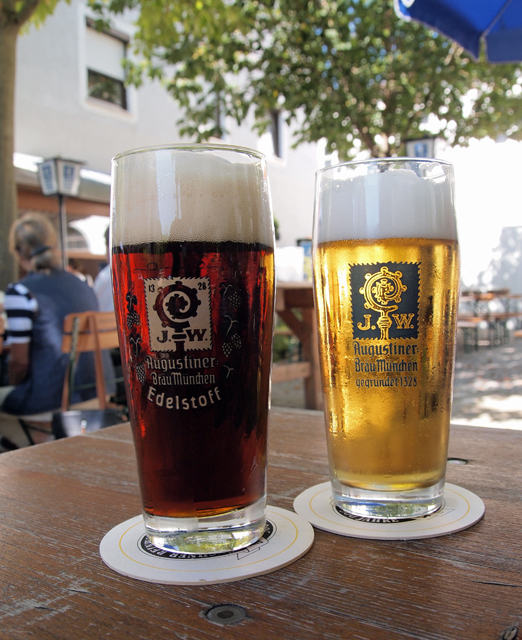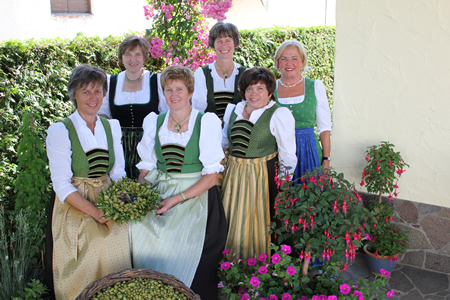Hopfenland - Kuchlbauer midsize brewery tour
 Friday, December 23, 2011 at 15:00
Friday, December 23, 2011 at 15:00 In a prior post about our weekend in "Hopfenland Hallertau" we toured the Lamplbräu microbrewery.
Now, we'll share our walk through a mid-size weissbier brewer called Kuchlbauer, in the town of Abensberg.
The entire experience here is called Kuchlbauer's Bierwelt (beer world) with a brewery, biergarten, art and info.
Like Lamplbräu, Kuchlbauer is privately owned. The same family has run it for seven generations (since 1904).
Whereas Lamplbräu was basically in the country (bordered a farm), Kuchlbauer is near a town center.
Also, unlike our "tour" at Lamplbräu (where I just called the owner, set a time, and he ushered us around personally), you have to purchase tickets for a Kuchlbauer tour at a specific time, with a guide & 40 other people.
We arrived early and had some time to kill before our tour started. Kuchlbauer has a biergarten too, so we went there. From outside its brick walls, you immediately see something quite different -- a strange, tall tower looms:
Next photo (below) is the biergarten entrance... what exactly is that thing, and why is it here? Stay tuned:
The inside of the biergarten is decorated much like the tower. They have a colorful, unique personality:
The tower is fenced-off and not accessible from the public area / biergarten - only through the tour.
The first biergarten customers we saw: nuns! A good sign for things to come? Absolutely.
After getting a snack, we went back to the "corporate" front entrance to find the tour's starting point.
The tour takes a couple of hours to complete and costs €11 for adults, €5 per child, and €7 per teen.
The intro video (in German) told us that we'll see the fusion of "beer and art" at Kuchlbauer. (Art??)
We followed our guide into the brewery for the start of the tour. First stop: the copper brewing kettles.
It's easy to see the size difference now between this operation and the Lamplbräu "Sudhaus":
Then, as at Lamplbräu, we saw the next step in the brewing process - nearby cooling and storage tanks:
Moving on through the tour (& brewing process) we saw antique equipment like this bottling machine...
... then their larger, modern bottling facilities (they were not active - the current batch was not yet ready):
From the tower (hang on, info coming soon...) you could see the shipping yard and one of their trucks.
It's not InBev of course, but Kuchlbauer is clearly more commercial than a classic Bavarian microbrewer:
Unlike Lamplbräu - which cycles batches between helles (a lager), pilsner (another lager), and weissbier (an ale) -
Kuchlbauer brews exclusively weissbier. The have six varieties available today (five are pictured below):
The varieties are, from left to right in the graphic above:
- "Sportsfreund" (sports friend)... basically a 'lite' dunkel weissbier, 40% less alcohol, 40% fewer calories
- "Alte Liebe" (old love)... a dunkel (dark) weissbier
- "Turmweisse" (turm = tower)... richer, uses a special malt, and has a higher 5.9% ABV (alcohol by volume)
- "Weisse" or "Helle Weisse"... a traditional Bavarian weisse, described as round and mild (vs. the Turm)
- "Aloysius"... named after a mythical Bavarian character, it's a dunkel bock weisse with a high 7.2% ABV
- [Not pictured] "Alkoholfrei"... alcohol free and low calorie weissbier
Note: Our friends at Regensblog told us Kuchlbauer *does* brew a helles (and they love it). We found it on Google, but no link to it on KB's web site. It must be brewed at another site and considered non-core to their brand.
The traditional weisse and the Turmweisse account for the vast majority of their output and branding.
The Turmweisse has the crazy tower on the label, and is available packaged with a unique weissbier glass:
(Keep reading -- we'll get to the "beer and art" explanation and tell the story behind the tower...)
This effectively ended the first part of the tour about the brewing process. Next came some data and history.
You may have noticed, in the very first photo, that their logo on the side of the building said: "since 1300".
Kuchlbauer is one of the oldest breweries in Germany. They have a list (below) with the 15 oldest continuously operating breweries in Bavaria. Kuchlbauer is 700+ years old (Munich's Weihenstephan is the oldest at 970).
They also had a map of all breweries in Bavaria (notice the bias towards Bavaria, and not Germany)...
... plus their wiessbier output (upper glass) relative to total Bavarian weissbier production (lower glass):
The lower glass made for quite a photo op by itself - Frau A could probably fit her head in the top of it:
Between the weissbier output comparison and the long list of Bavarian weissbier brewers, you realize just how many local microbreweries Bavaria must have (and how many more visits, tours, and tastings Frau A and I need to do).
Now the tour shifted focus again, concentrating on the topic of "beer and art". Getting closer to the tower...
Next, the guide led us down to a basement room in the main building, to a replica of Da Vinci's "Last Supper".
Yes, you read that correctly -- it's a half-scale reproduction of Leonardo Da Vinci's famous painting:
This replica is 8 meters wide and 3 meters high - the mounted television shows a short video to the group:
The video and then the guide tried to pull symbolism from the Last Supper and link it to beer, brewing, etc..
We didn't understand the details of how they claimed to link the two, sorry. But: the head of the brewery and developer of the tower, Leonhard Salleck, has such a strong interest in Da Vinci and this specific work that he wrote a book on it titled Der Schlüssel (The Key), available on Amazon.de. (No English translation available though.)
The next "beer and art" rooms/hallways were inspired by the artist who designed the tower. (Can you guess who?) They weren't designed by him, but in his style, and done in the main building during the tower's construction:
The decor of the room above is unique enough, but one specific feature is important to our story: dwarves.
The brewery owner likes dwarves, and uses them to tell visitors about the brewing ingredients, process, etc.
(Video below is about 3 minutes long, and a little dark, but gives you an idea of the Disney-esque feel.)
The dwarves will play an important role later in this post, about how the unique tower came into being:
The interesting designs continued into the next hallways & rooms, with beer bottler built into the walls:
Finally, we left the central building and went to the base of the tower (freestanding next to the brewery).
This is what everyone was waiting for -- the Kuchelbauer Tower (plaque below: "beer art tower"):
The tower has its own live webcam -- the latest photo is always available here.
As far as we could understand, here's the story behind the Kuchlbauer Turm:
Leonhard Salleck, head of the Kuchlbauer brewery, also has a strong personal interest in art. In the late 1990s, he dreamed of erecting a beer+art tower (it'd be a tourist draw and marketing tool). In 1998, Salleck contacted Austrian architect and painter Friedensreich Hundertwasser, asking him to design such a tower.
Hundertwasser initially declined.
But in 1999 Salleck sent another request. He wrote a short märchen (fairy tale) about the "weissbeer dwarves of Abensberg". The work, life, and mindset of the dwarves in his fairy tale communicted themes of brewing as art, and how brewing aligns closely with nature. (Hundertwasser was a nature lover; his buildings - like this tower - have trees growing in and through them). Finally, Salleck said that the Abensberg dwarves need a home.
Fortunately, Hundertwasser had some affinity towards dwarves (maybe why his designs are so childishly playful?) and his new response to Salleck's request was something like: "You guys in Abensberg are crazy... I'll do it".
Hundertwasser created the initial concept for the tower, but his apprentice Peter Pelikan handled the planning
(and eventual implementation).
Along the way, Salleck had trouble getting Abensberg to approve. First, German tradition (and often law) holds that nothing can stand taller than the town's church steeple. Second, local leaders thought it would be a blight on the town's aesthetics and history, and not a future landmark. To overcome the strong opposition, Salleck & Pelikan cut the tower's originally planned height in half. This was eventually approved. (It was ultimately a stroke of luck, because after the experience Salleck said that the larger version might have bankrupted the brewery.)
Hundertwasser died in 2000, at 71 years old, during the planning phase and before construction even started. Construction eventually began with the laying of the cornerstone in 2007. The 12-ton "onion" dome was mounted on the top in 2008, and the tower was opened to visitors in January 2010, just 20 months before our visit.
The tower stands 35m (114ft) tall, is 10m (33ft) in diameter, with the curves and colors of classic Hundertwasser.
(Further interesting information about the German engineering firms and software involved can be found here.)
The biergarten was later implemented at the foot of the tower and its grounds designed in a similar style.
Every December, Kuchlbauer erects a typical German Christmas Market in the biergarten space as well.
We entered the tower at ground level and immediately went down the stairs to the lower level.
Here, the tour guide gave a final speech and left the group to explore the tower independently.
On the other side of the "basement" is a wall of weissbier glasses from brewers around the globe.
With more than 4200 on display, it is the (claimed) largest collection of weissbier glasses in the world.
We took a short (24 second) video walking past the glasses, to give you an idea of exactly how many there are:
From this lower level, then you climb the stair to the top of the tower. Each level has another mosaic area, depicting important aspects in beer brewing. We'll cover those in a separate post. And then you descend to the beer garden and turn in your ticket for a Kuchelbauer beer of your choosing.
What is there left to say? This was one of the most, um, unique tours Frau A and I have experienced.
Of course, the last activity was heading to the gift shop and getting a six-pack (one of each kind)!
For a million+1 reasons, this is a great destination on any trip to non-Munich, non-Alpine Bavaria.
 Herr J ...
Herr J ...  Post a Comment
Post a Comment  Beer,
Beer,  Germany & German Culture tagged
Germany & German Culture tagged  Hallertau,
Hallertau,  Hopfenland,
Hopfenland,  Kuchlbauer,
Kuchlbauer,  beer,
beer,  weissbier ...
weissbier ...  Print Article
Print Article  Email Article
Email Article 



